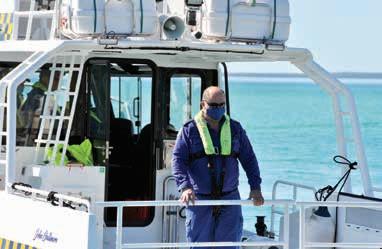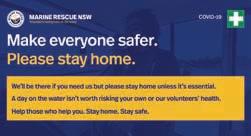
2 minute read
Strong Covid rules maintain health, services
Volunteers prove resilience and commitment again: Commissioner.
The emergence and rapid spread of the Delta strain of Covid has led Marine Rescue NSW to again introduce our strongest risk management protocols across the organisation to protect our people while maintaining our life saving services.
After a progressive return to “normal” operations, training and fundraising earlier this year, the organisation’s volunteers returned to social distancing in bases, meeting on Zoom and operating on-call in response to emergencies.
Commissioner Stacey Tannos said the organisation’s paramount priority was the health and welfare of its volunteers and staff.
“This always comes first. Always has, always will. No matter what,” he said. “Our members demonstrated their resilience and adaptability last year when we all learned how to function in a pandemic.
“They are again showing the same commitment and determination to stay safe while also maintaining our services to the boating community and pursuing their own training progression.”
The MRNSW Level Three protocols developed at the onset of the Coronavirus pandemic in March 2020 were re-introduced in late June when the State Government locked down the Greater Sydney Region, stretching from the Central Coast south to Shellharbour.
They extended to the Hunter Region and finally escalated to cover all 45 units when a statewide Covid lockdown was introduced on August 16. Relaxed regional restrictions saw all Northern Rivers units and MR Woolgoolga, Coffs Harbour, Nambucca, Trial Bay, Port Macquarie, Camden Haven, Alpine Lakes and Moama return to Level One protocols on September 11.
Personnel were encouraged to become vaccinated, particularly those in Local Government Areas of
Superboat Jervis Bay 41 was delivered in accordance with strict Covid protocols. Crew members, including Murray Hotchin, wore masks and social distanced during their inductions. Photo: Brad Whittaker.
concern, who could leave their LGA to report for duty as an authorised worker - but needed to be able to prove they had had at least their first vaccination or an exemption.
The delivery of the new superboat in the MRNSW fleet, Jervis Bay 41, to its home port was carried out in accordance with strict Covid rules. Critical members were able to undertake their inductions and initial training on board while observing requirements around social distancing, minimum crewing and wearing masks.
Members of MR Point Danger again faced a challenging border crossing and lengthy delays to access their base on Duranbah Beach, which is located in NSW but can only be reached by crossing briefly on to Queensland roads.
NSW Maritime clarified that boaters who were not living in a Local Government Area of concern were allowed to use their boat for recreation while observing rules around social gathering, physical distancing and mask wearing.
Boating was limited to two people, or more if all on board were from the same household. Boaters needed to be within their LGA or no further than 5km from home and were able to head up to 3nm offshore adjacent to their LGA.
MR bases reported that it had been quiet on the water, with few incidents troubling their crews.
From June 26, when the Greater Sydney regional lockdown began, until September 7, a total of 11,066 boats Loged On with an average of 2.8 people on board. In the early days of the pandemic last year, the average number of people on board
MR Lake Macquarie’s Garry Gray wears a mask on duty.
each Logged On vessel fell from three in March to 1.95 in April when distancing rules were clarified.











